Understanding the Envelopes Indicator available on Trading View
The Envelopes indicator, a powerful tool available on TradingView, is a technical analysis tool that helps traders identify potential entry and exit points in the market. It’s based on moving averages but with a slight twist, offering a visual representation of potential support and resistance levels. Let’s delve into a comprehensive guide on understanding and effectively utilizing the Envelopes indicator.
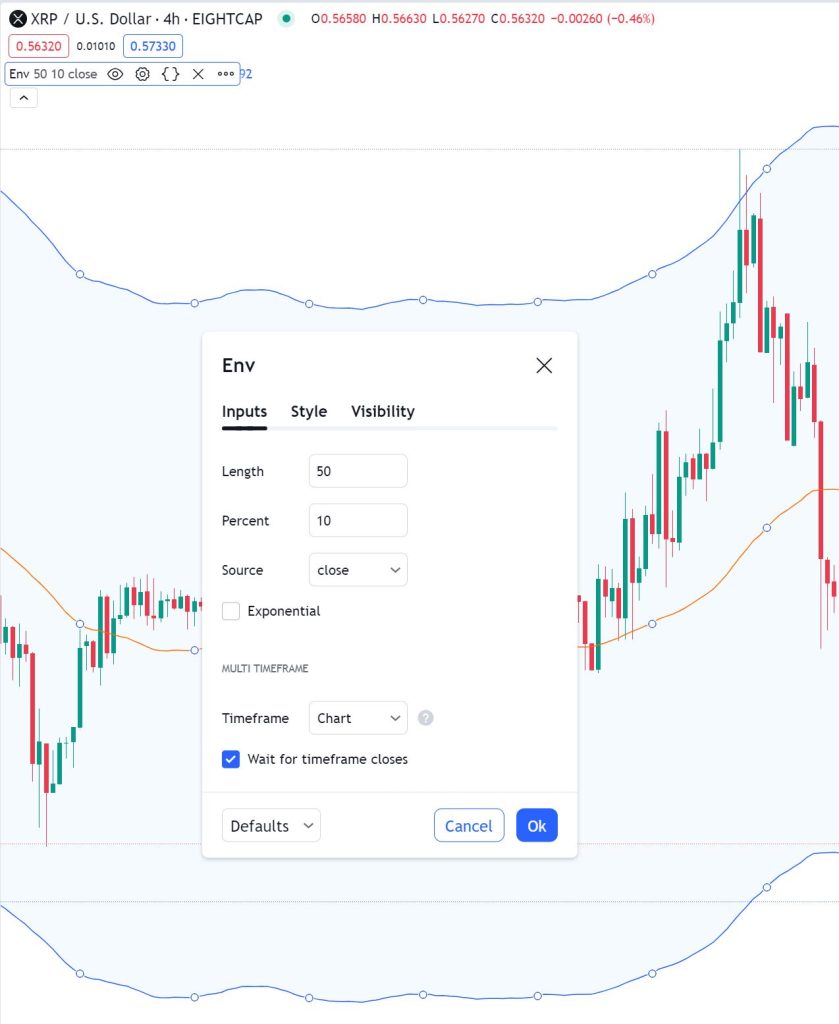
Understanding the Envelopes Indicator
What are Envelopes?
Envelopes consist of two parallel lines plotted above and below a simple moving average (SMA) of an asset’s price. These lines represent a certain percentage deviation from the SMA. The deviation is typically expressed as a percentage of the SMA and is used to create a band or “envelope” around the moving average.
Construction of Envelopes Indicator
Moving Average Component
- Simple Moving Average (SMA): The Envelopes indicator is centered around an SMA, which is a basic arithmetic mean of the asset’s prices over a specified period. This moving average acts as the baseline for the upper and lower envelope lines.
Deviation and Envelope Lines
- Percentage Deviation: Envelopes are typically constructed by adding a certain percentage deviation to the SMA to create the upper envelope line and subtracting the same percentage to form the lower envelope line.
- Customizable Parameters: Traders can adjust the settings, such as the period for the SMA and the percentage deviation, to suit different market conditions and timeframes.
Interpreting Envelopes
Trend Identification
Let’s consider a daily chart of a stock where Envelopes with a 12-day EMA and a 7% deviation are applied.
- Uptrend Identification: In an uptrend, prices tend to stay above or near the upper Envelopes band. If the stock consistently rides the upper band with occasional touches or pullbacks to the EMA, it suggests a strong uptrend.
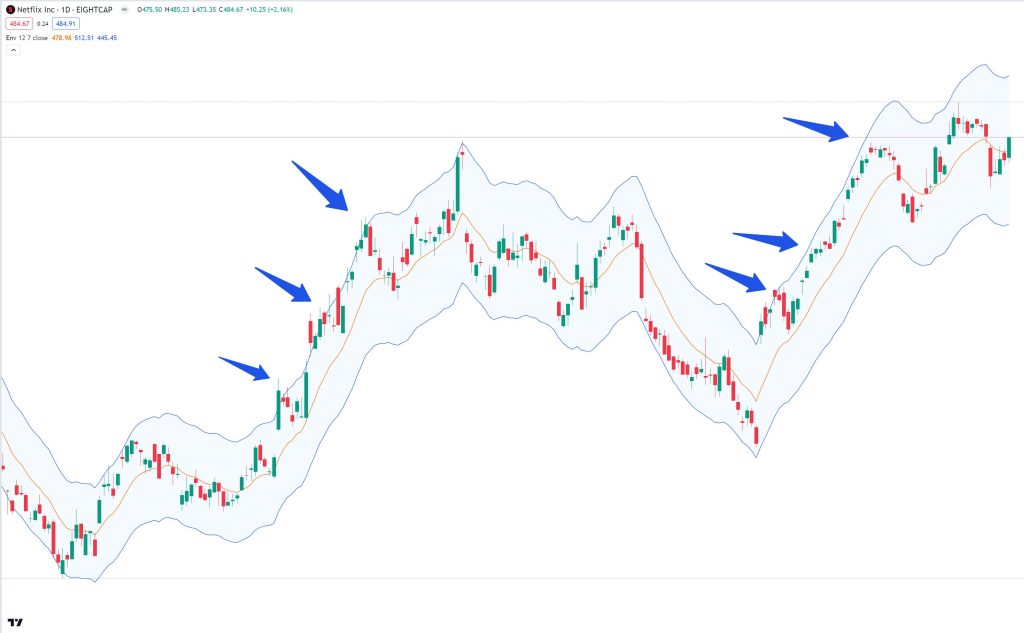
- Downtrend Identification: Conversely, in a downtrend, the stock’s prices might hug the lower Envelopes band. Occasional bounces from the lower band towards the EMA or upper band signify a downtrend’s strength.
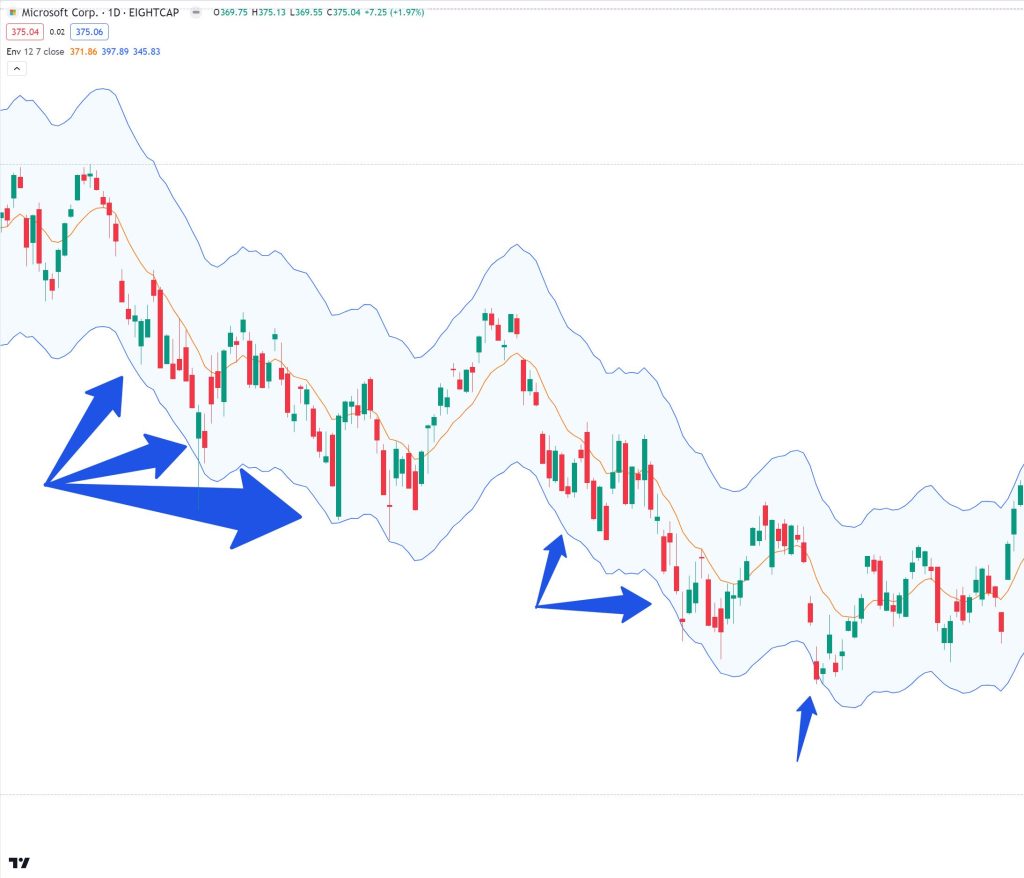
Support and Resistance
Let’s focus on a cryptocurrency pair using Envelopes with a 30-period EMA and a 5% deviation on a 4-hour chart.
- Dynamic Support and Resistance: As the cryptocurrency pair trends upwards, the upper Envelopes line acts as a dynamic resistance. Repeated attempts to breach this upper band often precede a pullback or consolidation. When bridged the upper band will turn into dynamic support
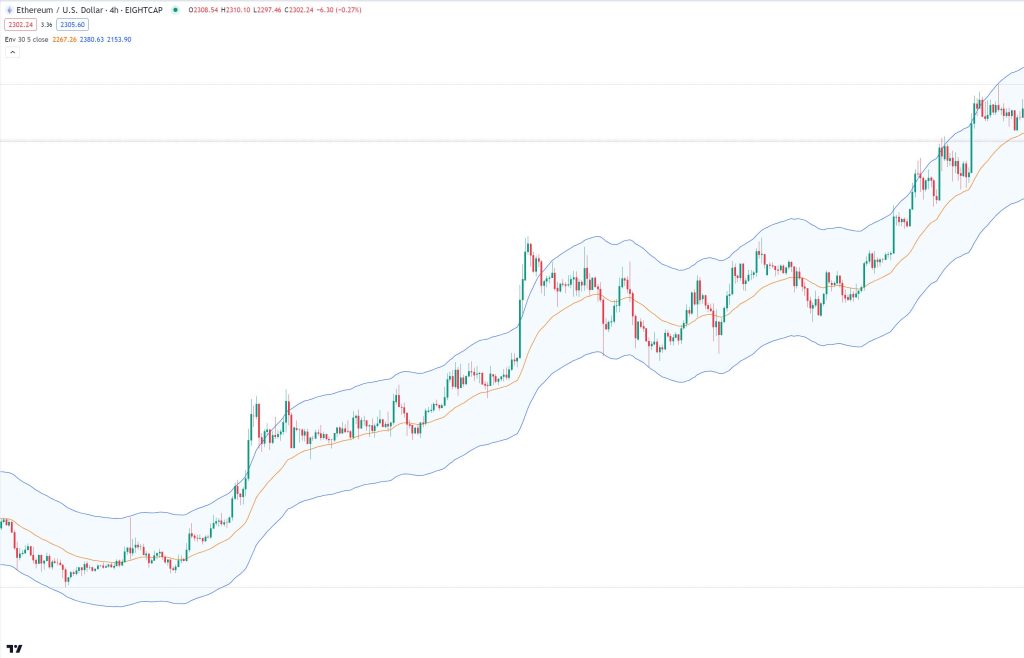
- Reversals at Envelopes: When the cryptocurrency pair hits the lower Envelopes band after a downtrend, it might signal a potential reversal point. Traders may watch for signs of a bounce or a shift in momentum.
Volatility Insights
Consider a forex pair with Envelopes using a 10-period SMA and a 1% deviation on a 1-hour chart.
- Volatility Expansion: During news events or significant market shifts, the Envelope bands widen, indicating increased volatility. Wide separation between the bands signifies higher price swings.
- Contraction and Consolidation: Conversely, periods of low volatility lead to a contraction of the bands. The price tends to trade within a narrower range between the bands during consolidation phases.
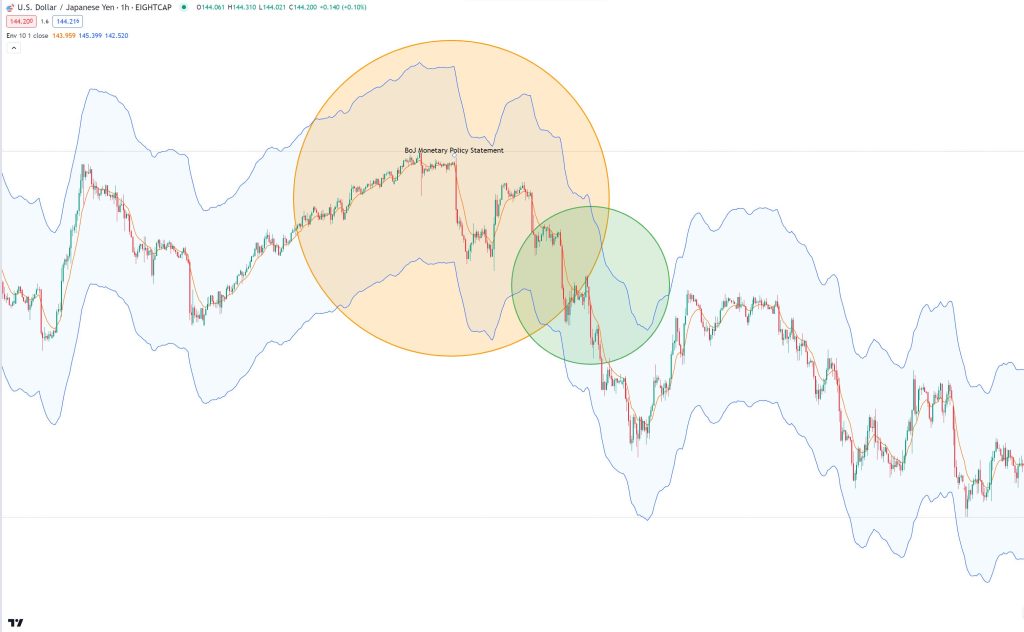
Practical Use with Breakouts and Reversals
Imagine a stock with Envelopes using a 15-day SMA and a 5% deviation on a daily chart.
- Breakouts: A stock consolidating within the Envelopes bands might experience a breakout when it breaches the upper or lower band. Breakouts through the upper band often signal a potential uptrend continuation, while breaches of the lower band could signal a potential downtrend continuation.
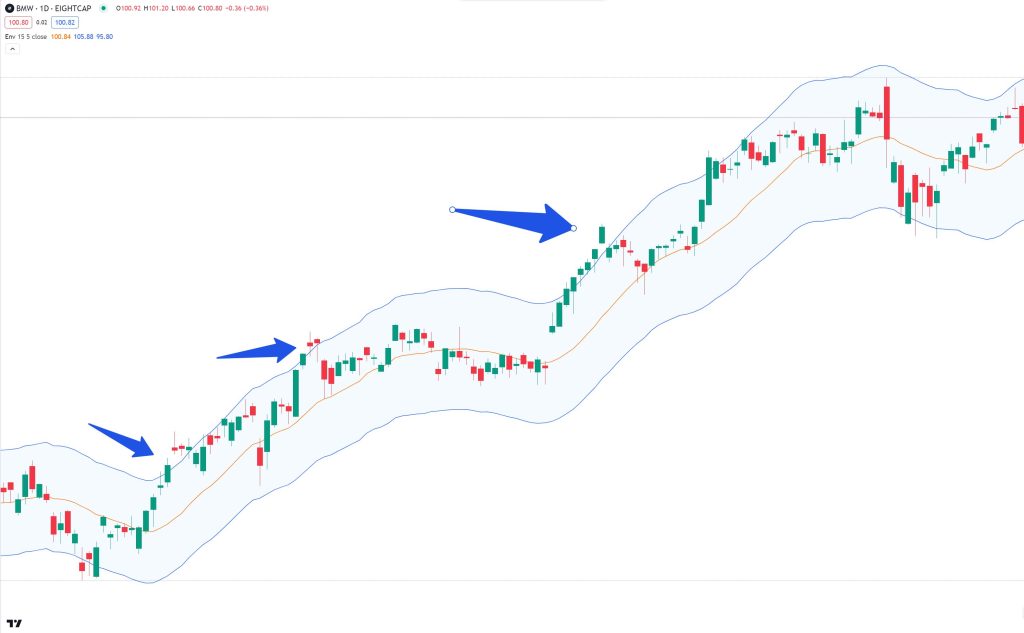
- Reversals Confirmation: After a prolonged uptrend, if the stock touches the upper Envelopes band and then reverses below the SMA, it might signal a potential trend reversal. Similarly, after a downtrend, a bounce from the lower band and subsequent move above the SMA might indicate a reversal.
Using the Envelopes indicator on TradingView
let’s delve deeper into the practical aspects of using the Envelopes indicator within TradingView.
Setting Up the Indicator
Customization:
- Selecting Envelopes: In TradingView, locate the Envelopes indicator among the available options.
- Adjusting Parameters: Customize the Envelopes by setting the parameters that suit your trading strategy:
- Moving Average Period: Determine the number of periods for the SMA. Shorter periods are more sensitive to price changes, while longer periods provide smoother averages.
- Moving Average Type: Choosing from the standard SMA or the faster EMA (Exponential Moving Average)
- Percentage Deviation: Set the percentage deviation from the SMA to create the upper and lower envelope lines. This determines the width of the bands.
Customizing the Envelopes indicator in TradingView involves adjusting its parameters to suit specific trading styles, asset classes, and market conditions. Here’s a more detailed breakdown of the customization options for maximizing accuracy:
Moving Average Period
Shorter Periods:
- Sensitivity to Price Changes: A shorter period for the SMA (Simple Moving Average) results in a more responsive line that closely follows recent price movements.
- Increased Noise: Shorter periods might generate more signals but could also produce false or premature signals due to increased sensitivity to price fluctuations.
Longer Periods:
- Smoothing Effect: Longer periods create smoother lines, filtering out short-term price fluctuations and providing a clearer view of the underlying trend.
- Reduced Sensitivity: Signals from longer-period SMAs might lag behind recent price movements, potentially missing early entry or exit points.
Percentage Deviation
Lower Percentage Deviation:
- Tighter Bands: Smaller deviations create narrower bands around the SMA, indicating a more conservative range for price movements.
- Fewer Signals: Tighter bands generate fewer signals, potentially reducing the number of trades but offering more confidence in those signals.
Higher Percentage Deviation:
- Wider Bands: Larger deviations result in wider bands around the SMA, accommodating greater price fluctuations.
- Increased Signals: Wider bands produce more signals, potentially leading to more trading opportunities, but might also generate more false signals during choppy markets.
Maximizing Accuracy
Backtesting:
- Historical Analysis: Test different combinations of SMA periods and percentage deviations on historical data to gauge how well they perform in different market conditions.
Market Analysis:
- Adapt to Asset Behavior: Different assets behave uniquely. Adjust the Envelopes parameters to match the specific volatility and characteristics of the asset being analyzed.
Confirmation from Other Indicators:
- Complementary Indicators: Combine Envelopes with other indicators (like RSI, MACD, or Bollinger Bands) to confirm signals and reduce false positives.
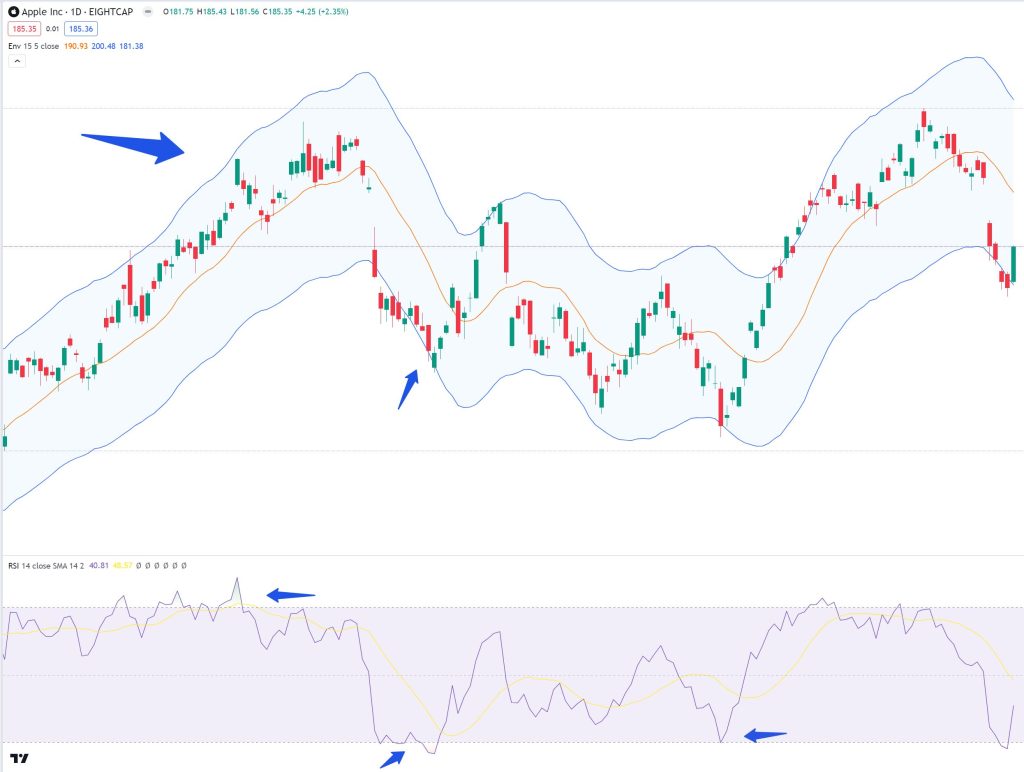
Trading Strategies
Confirmation with Other Indicators
Combining Indicators: Traders often use Envelopes in conjunction with other technical indicators to validate signals. For instance:
- RSI (Relative Strength Index): Confirm overbought or oversold conditions when Envelopes touch or breach the bands.
- MACD (Moving Average Convergence Divergence): Use MACD crossovers to confirm Envelopes-based signals.
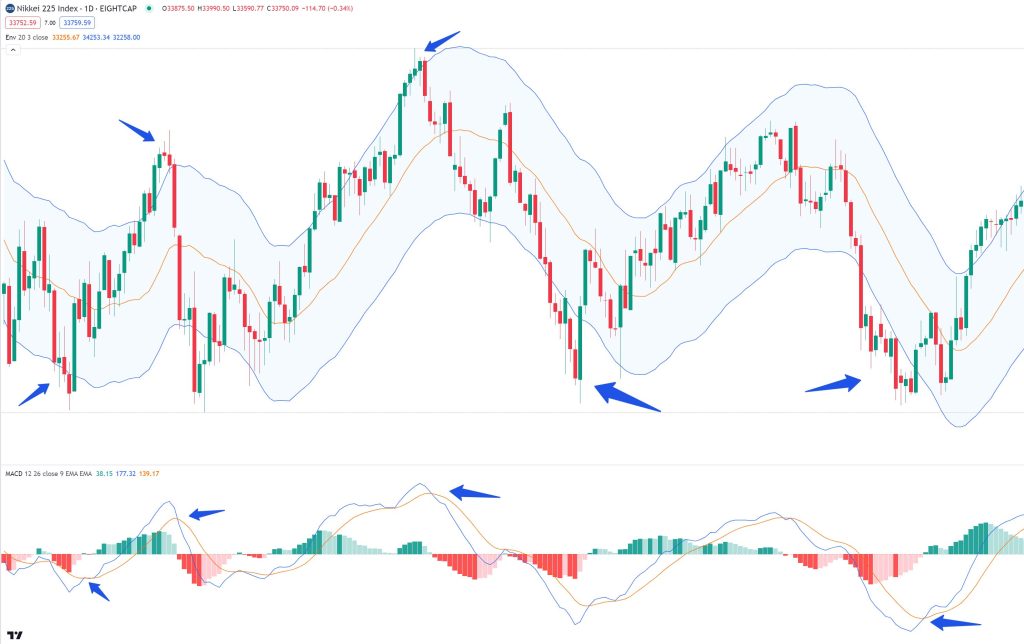
Risk Management
Stop Loss and Take Profit
- Implementing Orders: Use stop-loss orders to limit potential losses and take-profit orders to secure profits. These orders are based on the signals generated by the Envelopes indicator.
Position Sizing
- Determining Size: Adjust the size of your positions based on the risk tolerance and the strength of signals derived from the Envelopes indicator.
Timeframes and Adaptability
Suitability Across Timeframes
- Applicability: Envelopes can be applied across various timeframes. However, adjusting the settings for different timeframes might yield varying signals.
Adapting to Market Conditions
- Flexibility: Consider adapting the parameters of the Envelopes indicator based on changing market conditions. It might perform differently in ranging markets compared to trending markets.
While the Envelopes indicator can be applied to various asset classes, its efficiency often depends on the asset’s volatility, trend behavior, and historical price action. It’s crucial to conduct thorough analysis, backtesting, and adaptation to each asset’s specific characteristics to maximize the indicator’s effectiveness. Traders should use Envelopes as part of a comprehensive trading strategy, combining it with other indicators and analysis methods for more accurate decision-making across different asset classes. Customizing the Envelopes indicator involves finding the right balance between responsiveness and reliability. Experimentation, backtesting, and adapting to specific market conditions are essential for maximizing the accuracy of the Envelopes indicator. Traders should aim to fine-tune the parameters to suit their trading style, asset class, and the prevailing market environment for better decision-making.
Using the Envelopes indicator in TradingView involves customization, strategic application, and risk management. Traders can leverage Envelopes to identify trends, breakout opportunities, potential reversals, and manage risk through appropriate position sizing and the use of stop-loss and take-profit orders.
* The information provided here has been prepared by Eightcap’s team of analysts. All expressions of opinion are subject to change without notice. Any opinions made may be personal to the author and do not reflect the opinions of Eightcap.
In addition to the disclaimer on our website, the material on this page does not contain a record of our trading prices, or represent an offer or solicitation for a transaction in any financial instrument. Eightcap accepts no responsibility for any use that may be made of these comments and for any consequences that result. No representation or warranty is given as to the accuracy or completeness of this information. Consequently, any person acting on it does so entirely at their own risk. Any research provided does not have regard to the specific investment objectives, financial situation and needs of any specific person who may receive it. It has not been prepared in accordance with legal requirements designed to promote the independence of investment research and as such is considered to be a marketing communication.
Please note that past performance is not a guarantee or prediction of future performance. This communication must not be reproduced or further distributed without prior permission.


